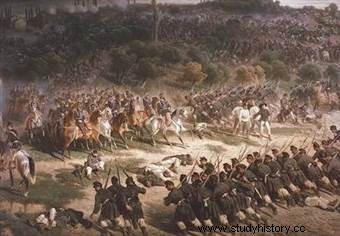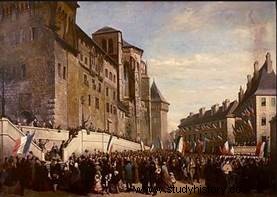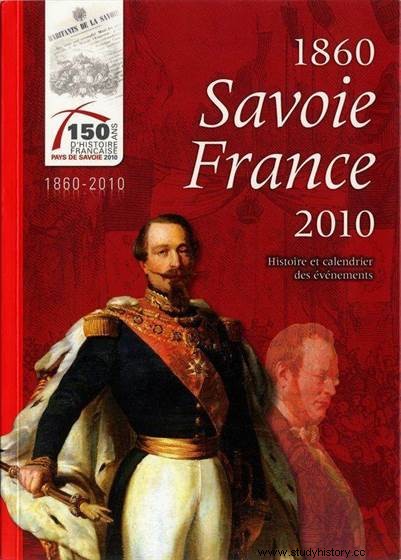 The attachment of Savoy and Nice to France is the result of a long process that began during the Revolution and which materialized during the Second Empire. In exchange for French aid against the Austrian occupation, the Kingdom of Piedmont-Sardinia proposed, by the Treaty of Turin of March 24, 1860, to cede Savoy and Nice to Napoleon III . This attachment to France becomes effective after a plebiscite organized among the people of Nice and the Savoyards. Occupied or temporarily annexed under Francis I, Louis XIV, the Revolution and the Empire, the Duchy of Savoy , just like the County of Nice , are definitively incorporated into France.
The attachment of Savoy and Nice to France is the result of a long process that began during the Revolution and which materialized during the Second Empire. In exchange for French aid against the Austrian occupation, the Kingdom of Piedmont-Sardinia proposed, by the Treaty of Turin of March 24, 1860, to cede Savoy and Nice to Napoleon III . This attachment to France becomes effective after a plebiscite organized among the people of Nice and the Savoyards. Occupied or temporarily annexed under Francis I, Louis XIV, the Revolution and the Empire, the Duchy of Savoy , just like the County of Nice , are definitively incorporated into France.
Nice and Savoy in the 19th century
Between 1792 and 1814, the county of Nice was a French department, that of the "Alpes-Maritimes", and the duchy of Savoy was the "department of Mont-Blanc". On April 23, 1814, the county of Nice returned to the Kingdom of Piedmont-Sardinia of Victor-Emmanuel I; it was not until the Treaty of Paris of 1815 that Savoy again became autonomous, close to an Italian policy. The Interview of Plombières, in 1858, concluded a secret treaty with the France of Napoleon III:in the event of a conflict between the Sardinian kingdom of the Austrian Empire, France promised its military support to the Kingdom of Piedmont-Sardinia. However, the treaty was not one-sided, since in exchange for its support, the French Empire obtained the Duchy of Savoy as well as the County of Nice. This secret treaty of alliance was ratified in Turin on January 26, 1859.
 It is therefore in a heavy political context that this transfer is gradually taking place; lively debates are then set up in France and Italy, and in particular in the city of Nice itself, which is an example in the matter. A question arises:how is the debate organized and concluded concerning the change of sovereignty of the Duchy of Savoy and the County of Nice?
It is therefore in a heavy political context that this transfer is gradually taking place; lively debates are then set up in France and Italy, and in particular in the city of Nice itself, which is an example in the matter. A question arises:how is the debate organized and concluded concerning the change of sovereignty of the Duchy of Savoy and the County of Nice?
At the origins of a change in sovereignty
The process of changing the sovereignty of the Duchy and Savoy and of the County of Nice was spread over several years, and had its sources in the unfolding of the Italian War of 1859 On May 3, 1859, after Sardinian provocations, the Austrian Empire declared war on the Kingdom of Piedmont-Sardinia; France, committed by a defensive alliance and without internal political opposition, decided in fact to honor the treaty. The Austrians then succeeded in invading Piedmont. It was not until the arrival of the French that the trend was reversed, thanks in particular to their significant victories at Magenta on June 4, 1859, and at Solferino on June 24, 1859. The armistice was signed on July 11 of the same year. in Villafranca.
By the Treaty of Zurich (November 10-11, 1859), Austria cedes Lombardy to France, which returns it to the Kingdom of Piedmont-Sardinia. France receives, subject to the vote of the populations, Nice and Savoy. From then on, with the end of the war in Italy, it seemed clear that the fate of the people of Nice and the Savoyards was a foregone conclusion:Nice, like Savoy, was destined to become French. Nevertheless, other scenarios have been considered:the maintenance of Savoy in the Sardinian fold, or even the attachment to the Helvetic Confederation, supported by the English. Faced with these different positions, diplomacy comes into play, and the political debate reveals all its importance.
The political debate around the Attachment
Niçois and Savoyards were then increasingly tired of the Kingdom of Piedmont-Sardinia, which hardly cared about them; the Piedmontese, for their part, were obsessed with the Risorgimento and the achievement of Italian unity. The great majority of these populations, in 1859, were therefore weary; they are not all in favor of joining the French Empire of Napoleon III, and, at the same time, no longer want to be linked to the Kingdom of Piedmont-Sardinia. The opening of this debate quickly took on a political, protesting form, notably called the “newspaper war” in Nice. The daily newspapers of the time are crucial revealers, and among them “The Future of the Alpes-Maritimes” or the “Nizzardo », favorable to Attachment.
 The majority of enlightened opinion does not turn towards France, however; she would like, for example, the establishment of a small independent state, on the very territory of the county of Nice, whose neutrality would be advantageous in the context of maritime trade, but also in the tourism sector - more and more " winter visitors", of all nationalities, then coming to stay in Nice. In France, the cession of Savoy is a possible solution, as a ransom for military and financial sacrifices. The populations of southern Savoy are very favorable to the Attachment, which could bring them military protection and capital commercial advantages. Nevertheless, the passage of French troops in 1859, who left to fight the Austrians, aroused great emotion among the people of Nice; the French army was very well received, even acclaimed in the city.
The majority of enlightened opinion does not turn towards France, however; she would like, for example, the establishment of a small independent state, on the very territory of the county of Nice, whose neutrality would be advantageous in the context of maritime trade, but also in the tourism sector - more and more " winter visitors", of all nationalities, then coming to stay in Nice. In France, the cession of Savoy is a possible solution, as a ransom for military and financial sacrifices. The populations of southern Savoy are very favorable to the Attachment, which could bring them military protection and capital commercial advantages. Nevertheless, the passage of French troops in 1859, who left to fight the Austrians, aroused great emotion among the people of Nice; the French army was very well received, even acclaimed in the city.
The Attachment of Savoy and Nice to France
The "Italian Campaign" of 1859 therefore allowed both to open the debate on the "Nice question", and to draw up a first overview of the opinions Savoyards, also called “Savoois”, and Niçois concerning the Attachment:the intellectuals were “against”, while the population was mainly “for”. It is therefore in this context that the gradual transition to French sovereignty took place. Napoleon III decided to schedule a popular consultation, the year following the conclusion of the Treaty of Zurich, in 1860, in the form of a plebiscite, as he used to do. This election was organized very quickly:it only took two and a half months for its implementation to be decided, at the end of January 1860.
 The 1
st
April Victor-Emmanuel II even spoke to the people of Nice:“If you have to follow other destinies, make sure that the French welcome you as brothers whom we have long learned to appreciate and esteem. Let your meeting in France be one more link between the two nations. ". Alea jacta est . The games therefore seemed already made, even before the popular consultation. The ballot was organized on April 15 and 16, 1860 in Nice, and on April 22 and 23 in Savoy. Unsurprisingly, to the question "Does Savoie/Nice want to be reunited with France?" “, the “yes” won by an overwhelming majority:more than 85% of those registered voted in favor in the County of Nice, and 96% in Savoie!
The 1
st
April Victor-Emmanuel II even spoke to the people of Nice:“If you have to follow other destinies, make sure that the French welcome you as brothers whom we have long learned to appreciate and esteem. Let your meeting in France be one more link between the two nations. ". Alea jacta est . The games therefore seemed already made, even before the popular consultation. The ballot was organized on April 15 and 16, 1860 in Nice, and on April 22 and 23 in Savoy. Unsurprisingly, to the question "Does Savoie/Nice want to be reunited with France?" “, the “yes” won by an overwhelming majority:more than 85% of those registered voted in favor in the County of Nice, and 96% in Savoie!
Despite heated debates and confrontations, the attachment of these territories to France was therefore acquired, both by diplomatic means, but also by popular means, referendum - by through ratification by the deputies of the Chambers of the Kingdom of Piedmont-Sardinia on May 29, 1860, and by an imperial decree of Napoleon III signed on June 12, 1860. The cession of the territories was organized, with great fanfare, on June 14 1860. Three new departments were then formed:in the late Duchy of Savoy, Savoy was created, with Chambéry as its prefecture, and Haute-Savoie, with Annecy as its capital; in the former County of Nice, the Alpes-Maritimes department was created, adding the district of Grasse, subtracted from the Var. On June 14, 1860, Nice and Savoy became, or rather became French again.
The debate concerning the change of sovereignty of the Duchy of Savoy and the County of Nice, attached to France in 1860, was therefore bitter in both regions. So much so that even today, certain independence associations such as the Savoisian League, seek to question the legitimacy of the Treaty of Turin, and therefore of the annexation of the territories... Qui satis expectat, prospera cuncta videt; time will tell!
Bibliography
- History of the annexation of Savoy to France, History of the annexation of Savoy to France, by P. Guichonnet. Siloam, 2000.
- P. GUICHONNET, C. SORREL, Savoy and Europe, 1860-2010. Historical Dictionary of the Annexation , The Fountain of Siloé, Collection “Les Savoisiennes”, Montmélian, 2009.
- R. SCHOR, Historical and Biographical Dictionary of the County of Nice, Serre, Nice, 2002.
